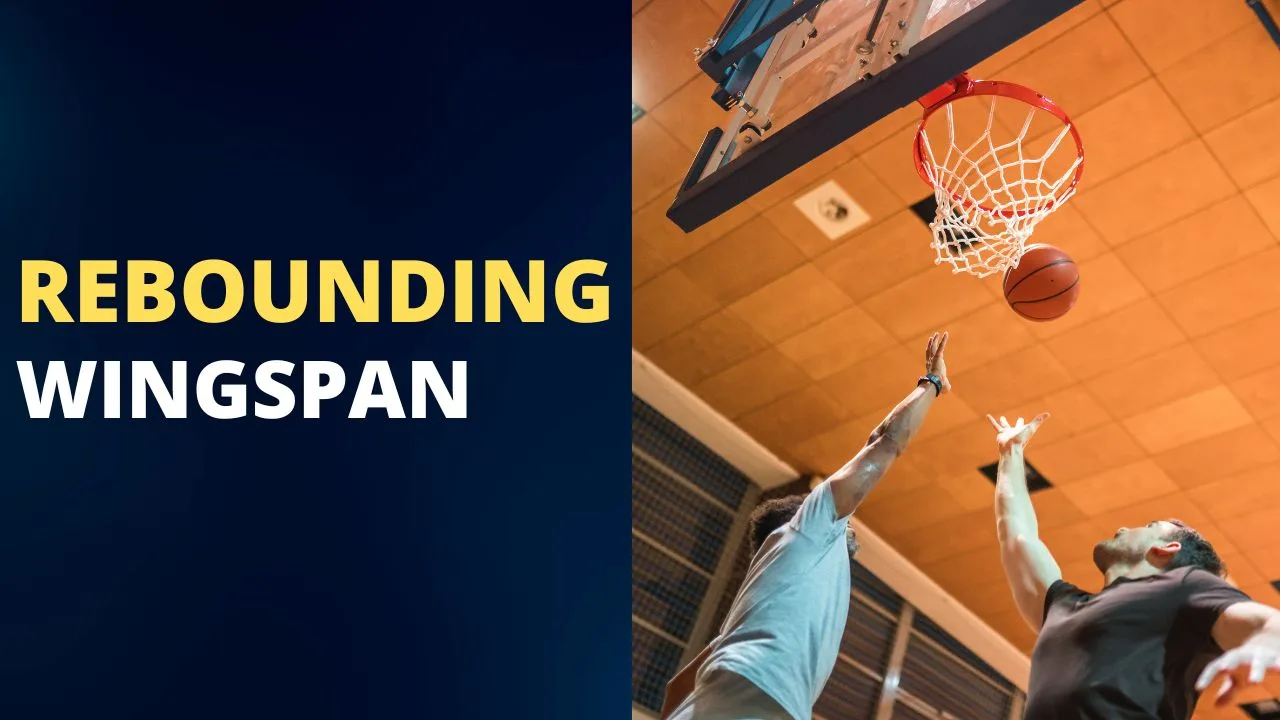Last Updated on: 7th February 2024, 11:58 pm

Have you ever witnessed a towering center snatch a seemingly impossible rebound, leaving opponents scratching their heads? The secret weapon might not be just their height, but something else lurking in their arms: wingspan.
This often-overlooked attribute stretches beyond just shooting prowess, playing a crucial role in the fierce battle for boards. So buckle up, basketball fanatics, as we dive into the fascinating world of wingspan and its dominating presence on the rebounding scene.
How Wingspan Extends Rebounding Prowess
Rebounding, especially on the defensive end, often boils down to one key element: reaching that ball first. And that’s where wingspan enters the equation, acting like a built-in cheat code for some players.
Imagine contesting a rebound against a giant like Rudy Gobert (7’9″ wingspan!), who effortlessly extends his arms and snags the ball out of midair. It’s not just the height that gives him an edge – it’s his extended reach that creates a larger rebounding radius. Think of it as an invisible force field, making it harder for opponents to penetrate and snatch the ball away.
A wider wingspan allows players to effectively seal off opponents, making it nearly impossible for them to squeeze in and challenge for the rebound.
Think of Draymond Green, notorious for his box-outs despite not being the tallest player on the court – his 7’1″ wingspan helps him establish dominance in the paint.
Diving into the Wingspan & Rebounding Data Vault
While witnessing a monster block-out or a seemingly impossible reach-in rebound is exciting, let’s get down to the cold, hard stats. Wingspan might seem like a qualitative advantage, but data paints a compelling picture of its quantitative impact on rebounding dominance:
- Board Battles by the Numbers: Imagine comparing the rebounding averages of players with exceptional wingspans like Giannis Antetokounmpo (7’3″) to those with more average wingspans. Chances are, you’ll see a clear correlation between longer reach and consistently higher rebounding numbers, especially in contested situations.
- Beyond Averages: But averages don’t tell the whole story. Dive deeper into specific rebounding categories like offensive, defensive, or contested rebounds. Here, the data often reveals an even bolder picture, showcasing how players with exceptional wingspan thrive in situations where reach is king.
- Positional Breakdown: Not all positions benefit equally from wingspan. Analyze data specific to centers, power forwards, and even guards, revealing how wingspan plays a nuanced role depending on the player’s primary defensive responsibility and rebounding location.
Get ready to see concrete data points, insightful visualizations, and expert opinions that solidify our discussion: wingspan isn’t just a physical attribute. It’s a statistically proven weapon in the arsenal of elite rebounders.
The Wingspan Whisperers: From Data to Domination
Data paints a convincing picture, but true magic happens on the court. Let’s meet some modern-day rebounding maestros who wield their wingspan like a wand, controlling the boards with unmatched authority:
1. The Greek Freak: Giannis Antetokounmpo (7’3″ wingspan) needs no introduction. His slight frame might seem unorthodox, but his wingspan is a rebounding Swiss army knife.
Whether it’s boxing out smaller players, snatching rebounds out of thin air, or tipping balls away with his outstretched arms, Giannis uses his reach to dominate the paint. Remember his monstrous 21-rebound performance against the Celtics in 2020? His wingspan enabled him to secure seemingly impossible boards, turning the game’s tide.
2. The Stifle Tower: Rudy Gobert (7’9″ wingspan) is a defensive anchor, and his wingspan is a significant reason why.
Imagine trying to muscle past his outstretched arms for a rebound – it’s like trying to reach over a tree branch. His box-outs are legendary, and his sheer reach shuts down entire areas of the paint. Witness his 27-rebound performance against the Warriors in 2017, a masterclass in using his wingspan to control the boards defensively.
3. The Draymond Enigma: Draymond Green (7’1″ wingspan) might not be the tallest, but his impact on the rebounding scene is undeniable.
His strategic positioning, relentless hustle, and surprisingly long arms make him a rebounding menace. Watch his 15-rebound performance against the Cavaliers in the 2017 Finals, where his box-outs and hustle, fueled by his wingspan, shut down even the biggest opponents.
Beyond the Reach: The Final Buzzer on Wingspan and Rebounding
We’ve explored the data, witnessed the magic on the court, and met the wingspan whisperers. But before we call it a game, remember, wingspan is just one piece of the rebounding puzzle:
1. The Symphony of Skills: Wingspan might create the long arms, but jumping ability is the slam dunk. Players like Dwight Howard or Blake Griffin showcase how vertical explosion amplifies the advantage of reach. Imagine Giannis’ rebounds without his sky-high leaps – wouldn’t be as dominant, right?
2. Strength Matters: Don’t underestimate the power of muscle. Players like DeAndre Jordan or Nikola Jokic use their strength and positioning to establish dominance in the paint, even with average wingspans. Remember Draymond Green’s relentless hustle? It’s not just his reach, but his strength that makes him a rebounding force.
3. Practice Makes Perfect: Let’s not forget the countless hours spent honing their craft. Every rebounding maestro has dedicated years drilling box-outs, perfecting positioning, and reading rebounding angles. Wingspan might offer a natural advantage, but it’s dedication that unlocks its true potential.
So, the next time you witness a monster rebound or an impossible reach-in, remember it’s a confluence of natural gifts, tireless practice, and a unique blend of physical attributes like wingspan. Appreciate the athleticism, delve deeper into the science, and remember, rebounding is a complex art, with wingspan playing a starring role, but never the sole act.
The Final Question: While wingspan offers an undeniable advantage, is it the ultimate rebounding factor? Share your thoughts in the comments below! Let’s discuss the other crucial skills, training methods, and even individual strategies that make players rebounding giants. After all, the conversation about rebounding goes beyond just arm length, and that’s where the real passion lies!
